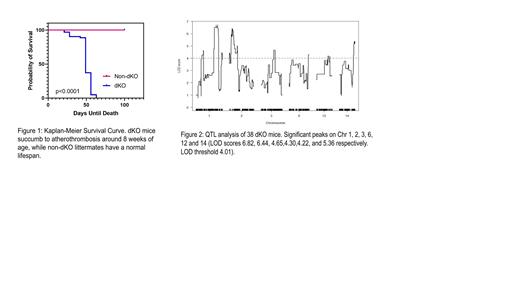Introduction: Atherothrombosis, or the formation of a thrombus on a ruptured atherosclerotic plaque, is a major health problem in western societies and can lead to myocardial infarction and ischemic stroke. Atherosclerotic plaques form on the inner walls of blood vessels and consist of macrophages, lipids, and prothrombotic molecules such as tissue factor that initiate the blood clotting process. Despite the complexity of atherothrombotic disease, with major (and evolving) environmental contributors, genetic variants play a role in modifying the disease process. In mice, deficiency of the Scavenger Receptor Class B type 1 (Scarb1) and Apolipoprotein E (ApoE) genes play important roles in the proper maintenance of lipid levels in the body. The Scarb1 protein is an HDL receptor known for its role in the process of transporting cholesterol from peripheral tissues toward the liver for excretion. The ApoE protein combines with lipids to form lipoproteins that package cholesterol and carry it throughout the circulation. In order to study mice deficient in these proteins, our lab produced Scarb1 and ApoE double knockout (dKO) mice on the C57BL/6J (B6) and 129S1/SvImJ (129S1) background and discovered major phenotypic differences in size and survival. Mice with a mixed 129S1/B6 background succumb to lethal atherothrombosis at approximately 8 weeks of age (as seen in Figure 1), whereas dKOs generated on the B6 background die at approximately 5 days old. We hypothesized that specific 129S1 genetic variants modify the severity of atherothrombosis in dKO mice.
Methods: We produced F1-F3 generation dKO mice on the mixed 129S1/B6 background for experiments. Weights were taken for the 38 dKO mice and their littermates from 3 weeks old until the death of the knockout mice at around 8 weeks of age. Purified DNA from the dKO mice was subjected to whole genome genotyping for 143,000 markers using the GigaMUGA genotyping platform (Neogen). Weight data were used as a phenotype to perform quantitative trait loci analysis (QTL) to identify potential loci responsible for the phenotypic weight differences.
Results: dKO mice from F1-F3 generations were born at the expected Mendelian frequencies but exhibited 3 distinct phenotypes based on their weights relative to their littermates. dKO mouse weights fell into 3 distinct categories: (1) indistinguishable from littermates, (2) 14%-39% less than littermates, (3) greater than 39% less than littermates. QTL analysis identified 6 loci above the significance threshold of 4.04 on Chromosomes (Chr) 1 (LOD 6.82), 2 (LOD 6.44) , 3 (LOD 4.65), 6 (LOD 4.30), 12 (LOD 4.22) and 14 (LOD 5.36; Figure 2). In addition, interaction analyses identified significant interactions of Chr 12 with Chrs 1, 2, 3, and 14. The Chr 12 candidate region is between 83 and 93 Mb consisting of 89 genes. Niemann Pick type C2 ( Npc2), an intracellular cholesterol transporter, is within the candidate region. Thus, 129S1 variants in this region affecting Npc2 transcription are strong candidates for modifying the dKO phenotypes.
Discussion: We have analyzed 38 dKO mice for genetic variants affecting their health, as measured by weights relative to their non dKO littermates. We identified 6 significant genetic loci, with Npc2 as a candidate gene for the Chromosome 12 locus. Studies to reinforce these findings include the analysis of an additional cohort of dKO mice to narrow the candidate QTL intervals, analysis of Npc2 expression in the B6 and 129 strain, histology of the liver to visualize lipid accumulation, blood smears to examine the blood cell size difference in dKOs, and sequencing with GigaMUGA. The identification of atherothrombosis modifier genes could result in novel treatment strategies for atherothrombosis.
Disclosures
No relevant conflicts of interest to declare.


This feature is available to Subscribers Only
Sign In or Create an Account Close Modal